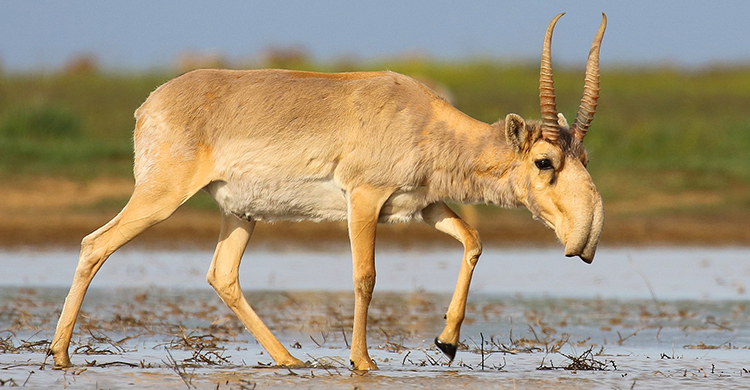Evolution tends to give many creatures mostly normal features, but inevitably drops the ball somewhere. All too often, especially for several members of this blog, the nose is that outlandish feature.The animal kingdom’s odd (and often ugly) members seem to compete for the title of weirdest nose. Our animal guest for today is certainly high on the leaderboard.

A male Saiga. Image Source.
Meet Saiga tatarica, commonly called the Saiga. It is an antelope that primarily lives in Central Asia, specifically in Kazakhstan and parts of southern Russia. There is also a population that lives in western Mongolia. Physiologically, they are quite similar to other antelope and roughly compare in size to a small white-tailed deer. They reside in dry grasslands and semi-arid deserts. The bizarre structure of their nose is believed to help filter out dust from their environment and warm the air they breathe during winter cold snaps. Male horns, as shown in the photo above, have a number of rings that make them unique.
Saiga antelope mother and her calf. Image Source.
Siaga live in migratory herds, traveling between summer and winter. They can travel huge distances during migration, going up to 1,000 kilometers. While Saiga are now confined to migrate within Central Asia, their historical range was enormous. In the Ice Age, herds used to be found throughout the rest of Europe and Central Asia, from what is now Great Britain in the west to what is now Alaska in the east.
The success of the Saiga, unfortunately, is a thing of the past. The IUCN Red List reports that Saiga are critically endangered. A variety of factors have contributed to this precipitous decline. Many of the issues Saiga face are directly related to humans. In Europe and Asia, the vast population boom of humans has limited space once available to Saiga. Their lengthy migration routes are now impeded and changed by farming, grazing, and settlement. Saiga are often hunted illegally. While their meat is eaten, the horns are sold for use in traditional Chinese medicine.

Image Source.
The situation Saiga face continues to be an up and down narrative. In 2015, the Saiga population had decreased to 5% of previous population numbers. Then, a previously unknown disease caused the rapid death of 200,000 of the already endangered species. This wiped out half of the remaining population. In 2018, the cause was determined to be a bacterial infection. This pandemic was connected with higher humidity and temperature than normal in the Saiga range, which may have allowed the bacteria to infect the antelope. Thankfully, Saiga are quite resilient, and recently the population has rebounded slightly from the brink of extinction. Moving forward, the Saiga requires the collective action of all governments within its range and the motivation of globally-minded citizens in order to preserve the floppy-nosed species for the future.
Cover Image Source.

acl5637 October 15, 2020
Wow — looks wise, evolution definitely did not favor this species. It’s interesting that their nose is formed that way to filter dust…I suppose that is logical given their environment. I also remember reading somewhere about the decrease in Saiga numbers; I think it was on some climate change article. That’s too bad because they seem like a really fascinating species!
Leah Mathews October 16, 2020
I’m certain I have never heard of or seen this animal anywhere before. It’s very interesting though and the nose is just something else. It’s sad that there are so many animals that are on the brink of extinction and I think a lot of that is because of humans which is even more sad. It’s probably also part of the reason I’ve never heard of some of these before. You write very well by the way and it’s clear and concise which makes it much more enjoyable to read. Good job!
kab7088 October 18, 2020
I have never heard of or seen the Siaga before. Their noses are extremely unique, I have never seen anything like that before. It is interesting to know that it helps these creatures filter out the dust from their environment. Although sad, I found it intriguing that factors due to the pandemic also affect animals such as the Siaga. It is good to know their population levels are increasing.
Supriya Kumar October 19, 2020
I remember seeing this animal in the Ice Age movies! It’s so interesting that that’s the function of their snout; it’s a reminder that aesthetic isn’t taken into account when anatomy is formed. It’s more about surviving and having traits that match our environment (which is why it’s unnatural for human–MAMMALS that should have hair–shave).